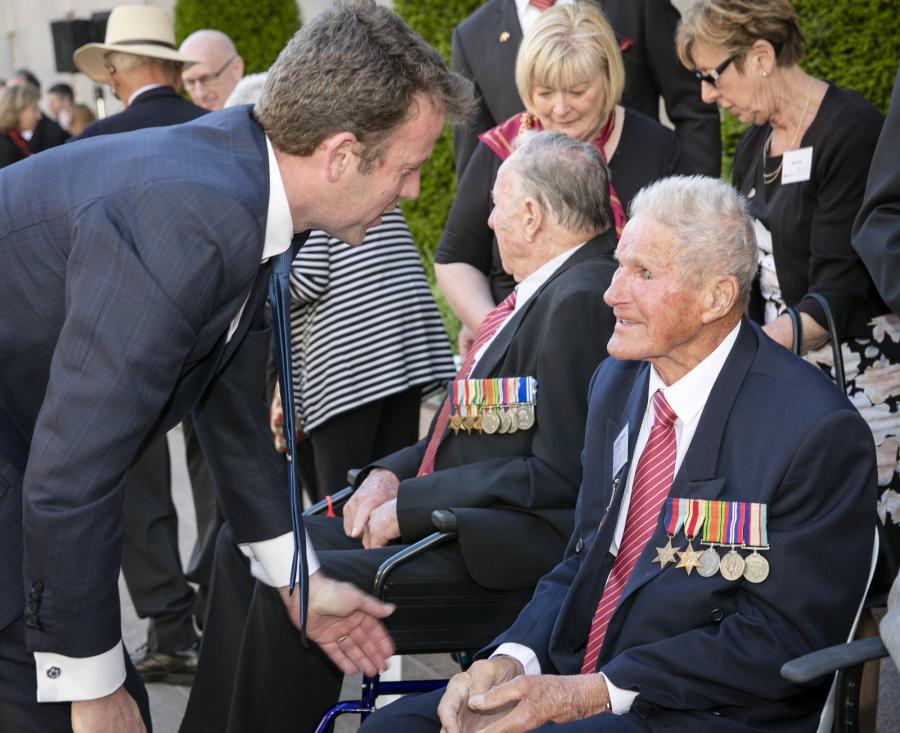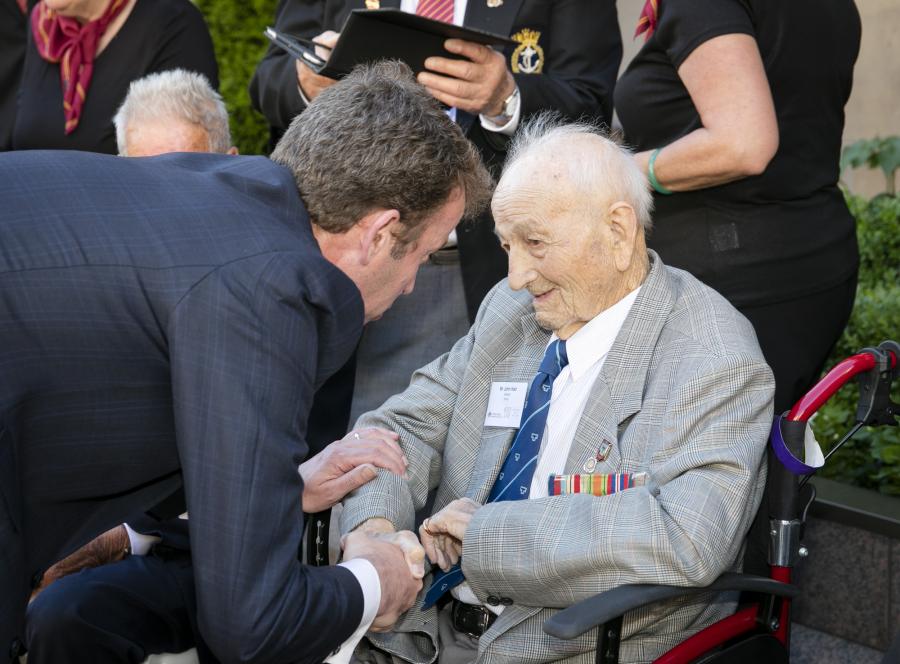'I thought he’d died there'
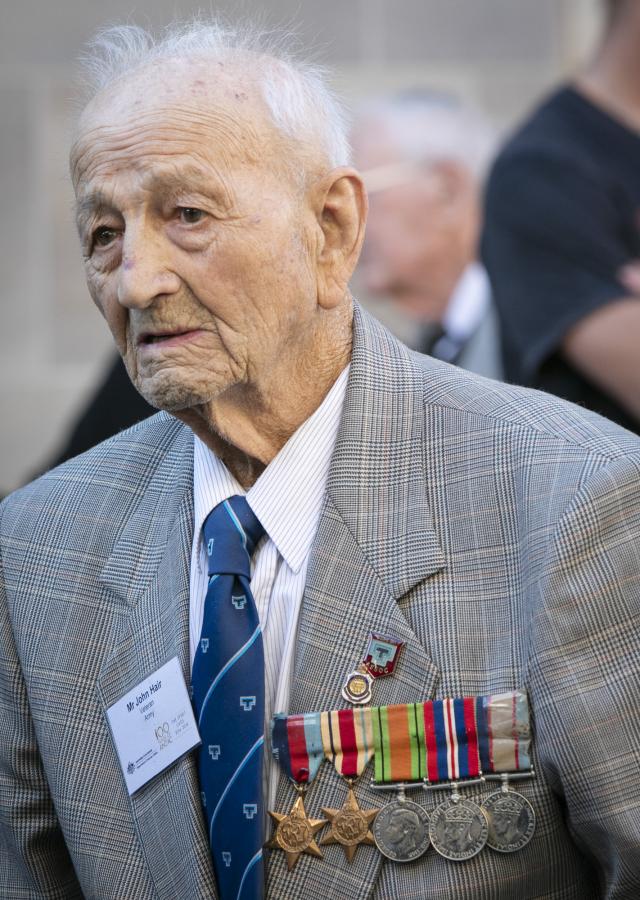
John Hair: "I got shrapnel in the leg and he got shot through the eye.”
John Hair and Frederick Maurer each thought the other was dead. They were wounded within days of each other during the battle of El Alamein in 1942, and both believed the other had died, until they were reunited at the Australian War Memorial more than seven decades later.
“I haven’t seen him in 75 years,” Maurer said. “He got hurt about six days in front of me … He hasn’t changed a bit. He’s still the same.”
The pair had each assumed the other was among the thousands who were killed during the fighting at the tiny Egyptian railway stop between July and November 1942.
“I thought he’d died there,” Hair said. “I knew who he was straight away. He looks just the same, just a little bit older and a little bit wiser.
“We [first] met up at the camp up at Darley [in Victoria……]… and he was in the same contingent as I was, and we went over to the Middle East on the Queen Mary in 1941. I got shrapnel in the leg and he got shot through the eye.”
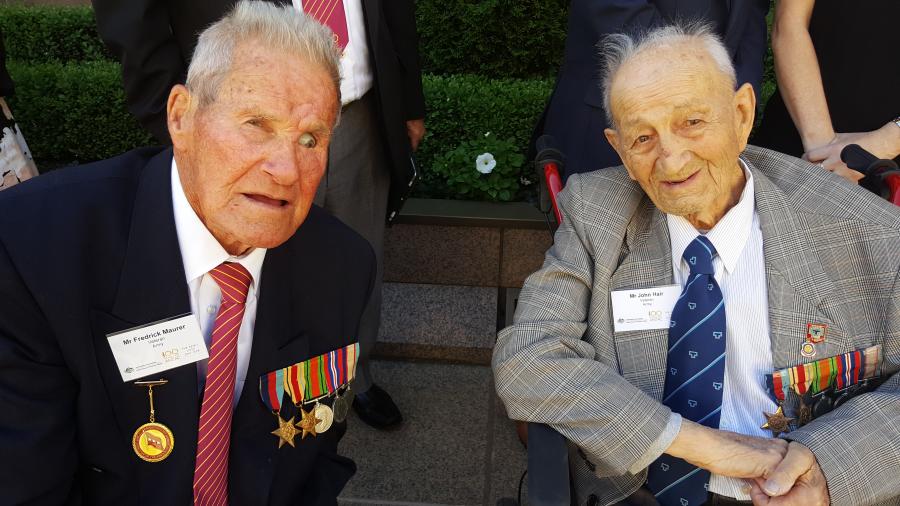
Frederick Maurer and John Hair: "He hasn’t changed a bit," Maurer said. "He’s still the same.”
Hair, now 94, was born in Coburg, Victoria, and was working as a hosiery mechanic at the local Holeproof factory when war broke out.
“My father was in the navy in the first war and my brother was a sea cadet before the Second World War. He was called up in September, and I wanted to join the navy myself,” he said.
“I sat for an exam, I passed the exam, and I was told to wait for a letter… I waited and waited… and the letter came, and it said they had enough personnel in the navy, but I could join the army or the air force, so three of us joined the militia…
“We were too young … so we joined the militia, and after three months of being in a searchlight unit, we found out we could transfer to the AIF by going to Royal Park, so we did that.
“We went up to a camp called Darley camp and we were there for a while, and after being in the militia for three months, I was made a corporal, and I did my AWOL after a while, and I lost my stripes.
“They called for volunteers to go to Darwin, and these two guys said to me, ‘Let’s go to Darwin,’ and I said, ‘No, bugger Darwin, I want to go to the Middle East.’ Well, they went to Darwin, and one of them was [later] beheaded, and the other one died as a POW.
“I went away, and came back, so I survived … I was lucky.”
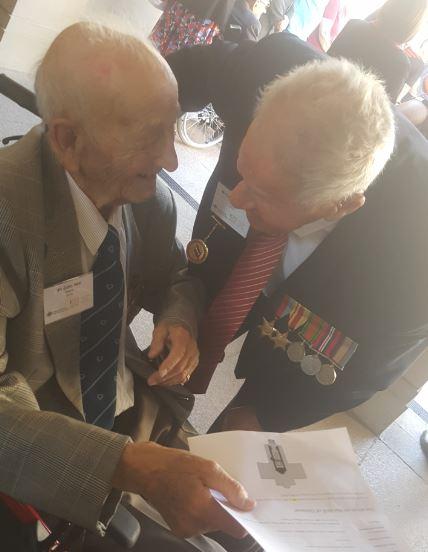
John Hair and Frederick Maurer. “I knew who he was straight away," Hair said.
Hair’s friend Frederick Maurer, now 95, was living in Greensborough, in the outer suburbs of Melbourne, and working as a butcher when he heard the declaration of war. In the spirit of adventure, Maurer joined up when he was under age so that he could see the other side of the world. He joined the militia first, and then transferred into the AIF, in order to avoid the age restriction, after his mates had already joined up.
Hair and Maurer arrived in the Middle East at the end of November 1941 and were assigned to the 2/23rd Battalion, nicknamed “Albury’s Own” because of the high number of recruits who had joined in Albury and Wodonga.
From Syria, Hair and Maurer were deployed straight to El Alamein in May 1942, when the battalion was being moved into Egypt as part of the British 8th Army to bolster the Allied forces fighting around El Alamein. The 9th Division, with support from tanks from the British 44th Royal Tank Regiment, was sent in to capture Tel el Eisa hill. After seven days of fierce fighting, they had captured Tel el Eisa and the German Signals Intercept Company 621, which had been intercepting British radio communications. Their capture marked a key achievement in safeguarding allied communications, movements and ultimately lives, but it was not without cost.
Between July and November 1942, three major battles took place around El Alamein, and Australians featured prominently in two of them. The decisive second battle of El Alamein began on 23 October 1942, with the Australian 9th Division playing a key role in the defeat of Field Marshall Erwin Rommel’s forces. Overall, the battles lasted for five months, and Australia suffered 6,000 casualties out of a force of 15,000. Hair was among those wounded.
“I joined the unit up in Syria, and from there, they worked their way around Lebanon, and up to the desert,” Hair said.
“They went into action on the 16th of July and I was wounded by a mortar shell – and the section leader next to me, and quite a few others – and that was the end of me.
“[In] the morning, there were heavy gunfire and mortar attacks, [and] D Company was told to dig in. There were prisoners everywhere coming in, and my section leader said to me, ‘Take those prisoners,’ and then over came the shells everywhere. I can’t remember what it was like … I was taken out, and I spent the next 18 months in hospital. And then I was discharged medically unfit.”
Hair was hit in the leg by shrapnel and was in hospital for the rest of 1942. He was moved to the Heidelberg Repatriation Hospital in 1943, and settled in Victoria, but never knew what had happened to his friend Maurer.
Maurer, who trained as an infantry soldier, remembers his battalion commander “came to the start line to wish us all good luck”. Maurer was in the advance party when he was wounded.
“I got a bullet,” he said simply. “I got it up through the cheekbone – it went through my cheekbone, through my eye and through my nose – and anyhow, I survived.”
Maurer was treated at the British General Hospital in Alexandria for three months before being transferred to the Australian Field Hospital. He was discharged in October 1943, and also settled in Victoria – but neither of the men knew of the other’s fate until they were reunited during commemorations at the Memorial marking the 75th anniversary of the battle.
“Well, it’s been 75 years,” Hair said, smiling. “Yeah, it’s a long time, but we’ve got each other’s address now, so we’ll correspond with each other.”
